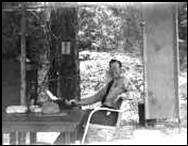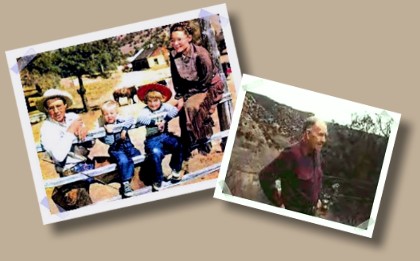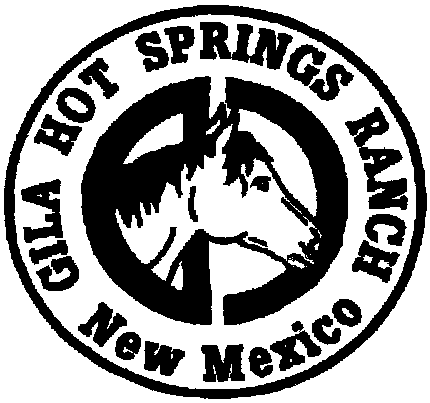|
In 1930, a 17 year-old boy arrived in Southern New Mexico's Gila Wilderness, seeking adventure - and relief from sinus problems. Dawson ("Doc") Campbell would soon become one of the most influential men in Southern New Mexico. He would become a trapper, ranch hand, custodian of the Gila Cliff Dwellings National Monument, Forest Service smoke-chaser and ranger, landholder, hunting and fishing outfitter, and general store owner. He would live the rest of his life in the Gila Hot Springs valley, about 40 miles north of Silver City, New Mexico, and pass away on May 11, 1998, at the age of 85.
Doc's tenure in the Gila spanned almost 70 years of intense change. Largely due to his influence, the Gila Cliff Dwellings National Monument, a series of caves that once housed Mogollon, Anasazi, and Apache Indians, would be transformed from a poorly protected and almost forgotten archeological site into a major tourist attraction. He would be a key player in the reintroduction of elk to the Gila. The road to the Gila Hot Springs valley would be paved and dial telephones installed in 1964. Electricity would come in 1970. Computers and modems, and with them, year-round residents, would arrive in the 1990s.
But all of that was still to come that fall in 1930, when young Doc bought his first burro and rode to an abandoned mining claim called Alum Camp, where he spent the ensuing winter. He tried his hand at trapping, without much success.
The next summer, Doc took a job at the Gila Hot Springs Ranch, a small resort on the West Fork of the Gila River managed by Mrs. Carl Scholl and her children. The resort had been developed by the Hills Brothers in the 1890s. Doc ran a pack string to the ranch over a rough trail from the Sapillo River, about 20 miles south of the ranch.
That job soon gave way to work on the XSX Ranch on the East Fork of the Gila River, owned by Teddy Roosevelt's cousin Hugh Hodges. Doc stayed there eight years, eventually becoming foreman.
In 1940, Doc bought the 320 acre Gila Hot Springs Ranch, combining his savings and a loan from the owner of the XSX. At first, he tried to run cattle and outfit too. But fishing and hunting seasons conflicted with busy times in the cattle business. He traded his cattle permit for a horse permit.
If outfitting was Doc's first love, he soon discovered another. Her name was Ida - and he asked her to make it Ida Campbell. But the main house on his new ranch was a bare-bones affair. In the 1880s, the Gila Hot Springs valley had been a thriving community. The house had been the post office and inn where the stagecoach stopped once a week. A separate building - which would eventually become their laundry room - had been the kitchen and dining room. Huge floods at the turn of the century forced most settlers to leave.
Before marrying Ida, Doc piped water to the house and installed a bathroom. Ida moved in, and they began the business of raising a family. They had four children: Becky, Ysabel, Angus, and Allen. In 1948, the Saturday Evening Post ran a feature on the Campbells, titled "The Wilderness Family." They stayed in the valley throughout the winters; other ranching families wintered in town. They raised their own meat, grew and canned their own vegetables. Trips to town were infrequent, maybe once every month and a half.
"It took us five or six hours to get to town," recalls Ysabel. "In the wintertime you didn't leave here until 10:00 or 11:00 at night when the ground froze. Or you'd go to town early in the morning and get in here to the ranch about 2:00 or 3:00 o'clock the next morning. If it was real bad, you rode to the Sapillo, went to town and picked up your supplies, and rode back."
|
|
|

|
|
| Doc Campbell at the first Gila Cliff Dwellings office Photo courtesy the Campbell family. |
|
|
|
Doc became custodian of the Cliff Dwellings National Monument on April 1, 1942, about the time Ysabel was four months old. He monitored the dwellings, transported visitors from the Sapillo, counted signatures on the register, and maintained the trail. He was paid 12 dollars a year for his efforts, partly because visitors were few. A locked gate at the head of the Copperas marked the Wilderness boundary, and only ranchers who lived in the valley had the key to the gate. The gate wasn't opened until two years after World War II when people in Jeeps breached the fence.
By 1949 things were tight. "The Forest Service decided everyone living within the Wilderness should be ousted," recalls Ida. "Doc's answer was to sell property to friends with plenty of political clout." Two early buyers were "Colonel" Clyde Ely, the editor and publisher of the Silver City Daily Press, and Chancie Snyder, president of the New Mexico Game Association.
"At the time we sold this land," Doc told Peter Russell in 1990, "we had a president or active member - had past presidents - of every service organization (in Grant County)." With the help of the new residents, a good road was bulldozed between the Sapillo and Gila Hot Springs. They lobbied the federal government to establish a corridor for a paved road through the wilderness to the Cliff Dwellings.
In 1955, things were looking grim for the monument. Southwestern National Monuments filed a report suggesting the dwellings be transferred to the New Mexico park system if the road were constructed. Doc, who was serving his first summer as a uniformed seasonal ranger, reacted immediately. He sent out letters and spent hours mapping the ruins around the area. He invited archaeologists from Santa Fe and Albuquerque to visit, drove them in, and showed them the extent of the ruins. "It's only because of my father that the Cliff Dwellings are still a national monument," says Ysabel. "He really fought for it."
By 1964, the Cliff Dwellings were an established national monument, and the treacherous, rocky road had become a paved highway that reached the Gila Hot Springs valley. Tourism exploded, and Doc opened Doc Campbell's Post, a general store. In 1967 the highway was extended to the Cliff Dwellings; today 60,000 tourists visit the monument annually. I like to think that Doc is still there at the entrance, tipping his hat to each and every one of them.
|
|



